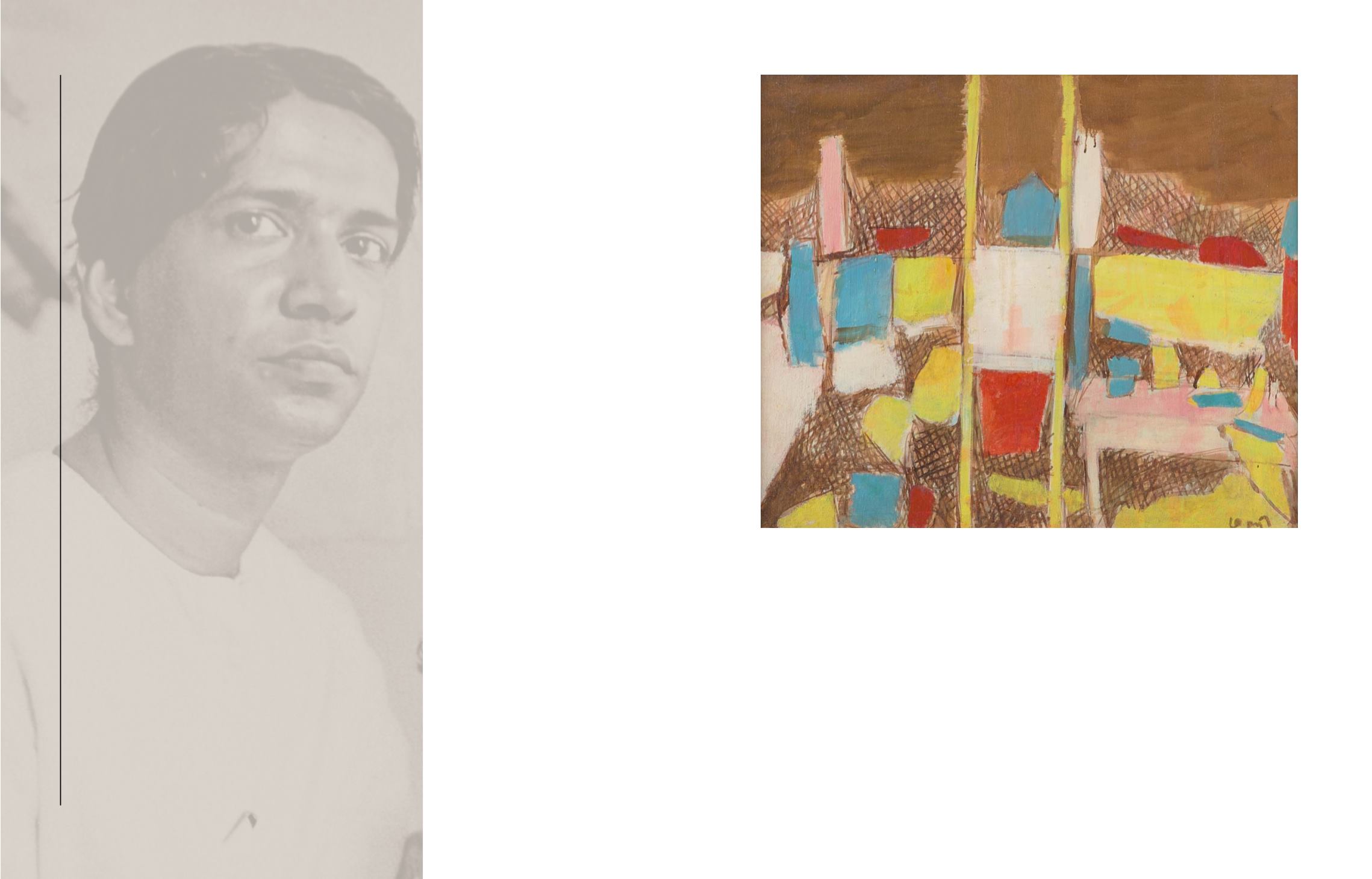

60
Saffronart | Evening Sale
Subramanyan studied art at Kala
Bhavan in Santiniketan, won a
fellowship at the Slade School of
Art at the University of London,
and spent a decade teaching in
Baroda. The present lot is a rare
work from the early 1960s, when
Subramanyan painted still lifes. His
work, till then mainly figurative,
took a turn towards cubism around
this time. Subramanyan had begun
working on still lifes after spending
two years as the Deputy Director of
Design (1959 – 1960) at the All India
Handloom Board in Bombay. His
time there had opened up several
avenues for exploring arts and
crafts, which also translated on to
the canvas. The present lot reflects
his interest in cubist abstraction,
which was being explored by
several Indian artists during this
period. The painting appears to be
“almost entirely surface, texture-
rich tapestries woven from painterly
scrawls, strokes and spots... But all
this does not reduce them to non-
representational visual poetry: the
visual and physical proximity of the
motifs... suggest the possibility of
touch and the convergence of the
optical and the tactile... In these
representations... the drawing both
clarifies and breaks down forms, or
alternately, the forms stand out and
merge into constellations, obliquely
giving rise to other composite
images.” (R Siva Kumar,
K.G.
Subramanyan: A Retrospective
, New
Delhi: National Gallery of Modern
Art, 2003, pp. 31-32)
1982
•
Participated in UK group exhibitions,
India: Myth and Reality
at the
Museum of Modern Art, Oxford,
Six Indian Artists
at the Tate Gallery,
London, and
Contemporary Indian Art
at the Royal Academy of Arts,
London.
1985
•
Made Fellow at the Lalit Kala Akademi, New Delhi
1991
•
Awarded the Gagan – Aban – Puraskar, Visvabharati, Santiniketan
1993
•
Conferred Fellowship, Kerala Lalit Kala Akademi, Kerala
1994
•
Awarded the Shiromani Puraskar, Kolkata
1996
•
Participated in
Chamatkara: Myth and Magic in Indian Art
at the Centre
for International Modern Art (CIMA), Kolkata and London
1999
•
Won the Kala Ratna at All India Fine Arts and Crafts Society (AIFACS),
New Delhi
2000
•
Awarded the Abanindra Puraskar, Kolkata
2001
•
Received Manaviyam Ravi Varma Award, Government of Kerala
2003
•
K.G. Subramanyan: A Retrospective
at the National Gallery of Modern
Art (NGMA), New Delhi and Mumbai
2004
•
Awarded the Lalit Kala Ratna Puraskar by the Lalit Kala Akademi, New
Delhi on the occasion of its Golden Jubilee
2005
•
Won the Lifetime Achievement Award at Academy of Fine Arts, Kolkata
2006
•
Received the Padma Bhushan from the Government of India
2011
•
Participated in group exhibitions
Ethos V: Indian Art Through the Lens
of History (1900 to 1980)
at Indigo Blue Art, Singapore and
Roots in the
Air, Branches Below: Modern & Contemporary Art from India
at the San
Jose Museum of Art, San Jose, and
Time Unfolded
at the Kiran Nadar
Museum of Art (KNMA), New Delhi
2012
•
Received the Padma Vibhushan from the Government of India
2016
•
Passed away at the age of 92
61
20
K G SUBRAMANYAN
(1924 ‒ 2016)
Untitled
Initialled in Tamil (lower right)
Acrylic on canvas
22.5 x 27 in (57.2 x 68.5 cm)
Rs 10,00,000 ‒ 15,00,000
$ 15,155 ‒ 22,730
PROVENANCE:
Private Collection, Mumbai
Subramanyan aimed for ambiguity in his works, as seen
in the present lot. There is a quality of animation about
the abstract forms that transcends a mere compositional
interest. “Gestural animation was also at the heart of
Subramanyan’s paintings from the mid-sixties. In the
works done during 1964-65 he moved from the limited
and proximate space of the table to the still intimate but
larger space of the studio and the domestic interior...In these
he also made his first cautious move from the graphic to
the painterly, from contours defined by lines to contours
marked by the variegated edge of colours, usually bright and
sometimes dripping; images losing definition but gaining in
suggestive ambivalence.” (Kumar, p. 37)


















